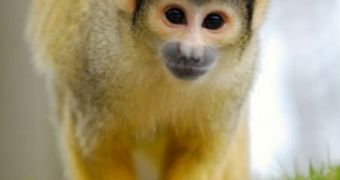Scientists at the American space agency are currently getting ready to perform a new series of radiation tests on a group of squirrel monkeys. The study will attempt to determine the possible effects that prolonged radiation exposure may have on astronauts during long-duration spaceflight to other planets, such as to Mars, for instance. The animals will be exposed to gamma-rays, the most powerful type of radiation in the Universe, composed of the most energetic type of photons, Space reports. The new instance would be the first in decades when NASA experiments on animals.
In the early days of the space program, in the early 1950s, it was common practice at the space agency to test various aspects of orbital journeys on monkeys. At the time, the public opinion was influenced by the fact that the Russians were way ahead of the United States, and as such needed to be caught up with. Additionally, no one was really interested with animal welfare at the time. More recently, NASA has renounced this practice, which animal protection groups labeled as inhumane. However, on the brink of a new age in space exploration, the space agency may have to break its own protocols again.
“The overall objective of the planned studies with the nonhuman primates is to help NASA predict neurobehavioral effects of space radiation, which are among the most poorly understood health risks for astronauts,” Bill Jeffs, a NASA spokesman, said. He explained that the study would revolve around 27 squirrel monkeys being subjected to high-energy gamma-rays. After the exposure period, the way in which the animals perform the various tasks they are assigned will be analyzed, and the health risks of astronauts assessed based on this information. As it recently became obvious, technological and scientific limitations are last on the list when it comes to issues preventing long-term space flights.
“NASA-funded research has shown that simulated space radiation can affect nerve cells in culture and also the behavior of mice and rats, but these studies are limited in the extent they can be extrapolated to human behavior and performance. Studies in nonhuman primates are essential to be able to best predict neurobehavioral effects of radiation on humans,” Jeffs added. Already, some people have voiced their disapproval of the $1.75 million study.
Some 100,000 doctors, nurses and laypersons recently signed a petition asking NASA to refrain from such cruel and inhumane testings, calling the decision “one giant leap backward for NASA”, Florida Today reports. But NASA says that, while it may appear brutal, this type of research is the same that was conducted before, and also essential for future space exploration. “Currently, there is no information regarding the effects of space radiation on neurobehavioral function in nonhuman primates,” Jeffs mentioned.
Other scientists also defended the need for such testing, saying that, “due to their phylogenetic proximity to human beings, non-human primates provide a research subject as close to humans as possible.” University of Texas M. D. Anderson Cancer Center expert Christian R. Abee noted: “Therefore, they are the ultimate translational science subject for many studies.”

 14 DAY TRIAL //
14 DAY TRIAL //